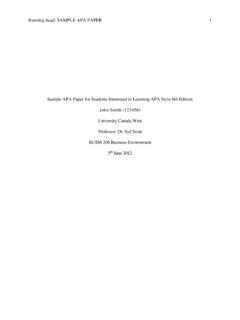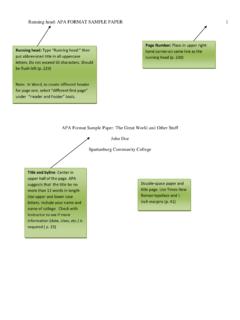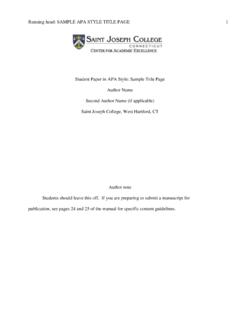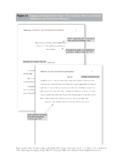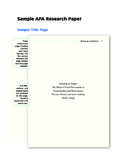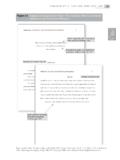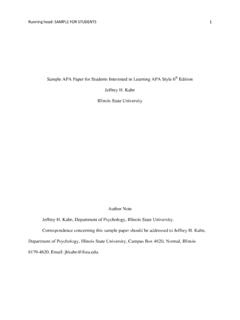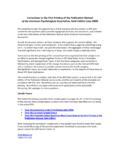Transcription of Running head: WRITING AN APA REPORT
1 WRITING an apa paper 1 Running head: WRITING AN APA REPORT WRITING an APA Style REPORT Author s Name California State University, Northridge (don t include the information below) Originally prepared by Matthew Chin and Valerie Sims. Revised by Mary Hegarty and Jill Quilici. Much of it was adapted from the Publication Manual of the American Psychological Association (5th edition) and Cozby (1989) Methods in Behavioral Research. WRITING an apa paper 2 Abstract The abstract is a short (100-150 word) paragraph that summarizes the key points of your article. The abstract is a way that people find out quickly what an article is about. It should describe the problem investigated, the hypothesis of the experiment, the method used to test the hypothesis, the results, the conclusions, and the theoretical implications of the research findings.
2 WRITING an apa paper 3 WRITING an APA Style REPORT The introduction tells the reader about the problem to be studied and why it is important and interesting. You should start by introducing the reader to the general problem being studied. Then you should review the relevant literature on the topic. This review should include a description of relevant theories on this topic and previous experimental research that has been conducted on this topic. You should then describe any changes or additions that you made to the methodology of previous studies, and your theoretical motivation for making these changes. Finally, you should describe your hypotheses or predictions about the results and again these should be theoretically motivated. Your theory and hypotheses should be logically derived from past theories of experimental results.
3 Although it is important that some relevant past experiments be described briefly, make sure that your introduction is not simply a number of short summaries of past studies. It is vital that you link the past research that you describe with your present theoretical concerns. Note that sometimes you have no way of knowing a priori what effect a variable will have, but want to explore its effects. In this case, it is better to say that you explored the effects of this variable than to try to make up a hypothesis that you can t justify theoretically. In other cases, an experiment is done to decide between two competing hypotheses. In this case, you should describe the two hypotheses and outline what the pattern of results should be if each of the hypotheses is correct. Method The method should contain enough information that another experimenter could replicate your study.
4 It is divided into the following sections. Make sure that you describe each piece of WRITING an apa paper 4 information relevant to the method in the appropriate section. You should not have any text between the method heading and the participants heading. Participants This subsection should describe relevant characteristics about the participants in your experiment (note that we no longer use the word subject in referring to our experimental participants). You should specify the number of participants, where they came from ( , a lab class at California State University, Northridge) and mention any compensation they received (course credit, money, etc.). If you used a between-subjects design, mention how subjects were assigned to the different groups in the experiment. You might also mention the gender breakdown and age of the subjects.
5 Design In this section identify the independent and dependent variables and the different levels of the independent variables. Be sure to state which independent variables were between subjects and which were within subjects. When identifying dependent variables, do not use vague terms like score . Instead use more specific terms like percent recall or reaction time in milliseconds . Materials This section should describe the stimulus materials used in your study. If you used special equipment ( , computers, specialized software), you also need to include an apparatus section. Procedure This section should describe how the experiment was conducted in some detail. Describe everything that happened to typical participants in your experiment from the beginning of the WRITING an apa paper 5 experiment (including instructions) to when they were thanked and dismissed.
6 Again, it should be at a level of detail appropriate to another researcher who wants to replicate your experiment. Results The results section should describe the data from your experiment. It is important to describe both descriptive and inferential statistics that you performed on your data. Descriptive statistics are the means, standard deviations, and standard errors for the different conditions in your experiment. These can be reported either in the text, a table or figure (my preference is to present data in figures as much as possible) and they should only be presented in one format. Tables and figures of your data should be placed in the back of your paper . If you use a table or figure, be sure to refer to it in the text at the relevant point. Inferential statistics are the statistical tests that you performed ( , ANOVA, t-test).
7 In reporting your statistical results, you should REPORT the statistic (t, F, etc.) and the degrees of freedom. Although the main discussion of your results occurs in the discussion section, you should briefly remind your reader of each major hypothesis before presenting the data relevant to that hypothesis. You should also point out the trends in your data here (noting whether they fit the predicted patterns) but do not discuss the theoretical implications of your data. Discussion The discussion should explain the meaning and implications of your results. If you have significant effects that match your a priori hypotheses, then you should have no problem explaining what they mean. However, you also need to discuss significant results that do not fit with your hypotheses. Likewise, nonsignificant results should also be discussed.
8 In discussing why your results did not fit with your hypotheses, or the results of other research in this topic, you should think about ways in which your experiment differed from WRITING an apa paper 6 previous research. The most common reason given by students for why they did not get the predicted results in an experiment is that the sample size was too small. This is a possible explanation if (1) your sample size was smaller than that in similar experiments in the literature and (2) the pattern of results that you observed conformed to your hypotheses but the results were just not significant. Even if these two conditions apply, there might be some other reason why your results did not fit the predicted patterns. It could be that your original predictions were correct, but your methodology did not test them sufficiently.
9 On the other hand, perhaps your original predictions were incorrect and the data from your experiment are indicative of what is really true. Is a competing theory supported by your data? Remember that a confounding variable might provide an alternative explanation for your results. Finally, any suggestions for future experiments should be described briefly. If your experiment did not conform to your predictions, maybe another experiment could explain why. Scientists often have their best ideas for experiments when they are trying to decide why another experiment doesn t work. WRITING an apa paper 7 References Abboud, H. A. (1999). Superlab pro : The experimental lab software. [computer program] Phoenix, AZ: Cedrus Corporation. Aronson, E. (1984). The social animal (4th ed.). San Francisco: W. H. Freeman.
10 Becker, L. J., & Seligman, C. (1981). Welcome to the energy crisis. Journal of Social Issues, 37, 1-7. Bersheid, E. & Walster, E. (1974). Physical attractiveness. In L. Berkowitz (Ed.), Advances in experimental social psychology (Vol. 7, pp. 145-198). New York: Academic Press. Chomsky, N. (1979). Language and responsibility. New York: Pantheon. Gurman, A. S. & Kniskern, D. P. (1981). Family therapy outcome research: Knowns and unknowns. In A. S. Gurman & D. P. Kniskern (Eds.), Handbook of family therapy (pp. 741-775). New York: Brunner/Mazel. Paivio, A. (1975). Perceptual comparisons through the mind s eye. Memory and Cognition, 3, 635-647. (The list of references should directly follow the discussion section but begin on a new page. Any sources cited in your REPORT should be listed here. Notice how the references are alphabetized according to first author so the Becker article is listed before the Bersheid chapter.)










